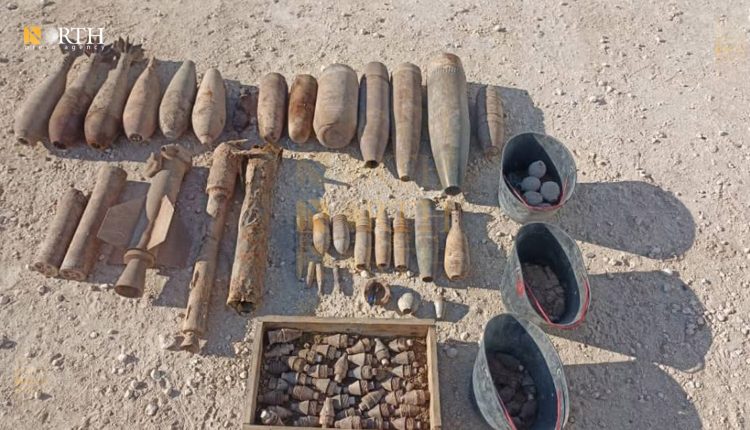Syria Reports 12 Demining Workers Killed Amid Ongoing Threat of War Remnants
By Kardo Roj
DAMASCUS, Syria (North Press) – Syria’s Ministry of Defense announced on Monday that 12 demining workers were killed and approximately 20 others injured or permanently disabled over the past several months while conducting explosive ordnance clearance operations across the country.
The statement underscores the immense danger posed by unexploded ordnance (UXO) and landmines left behind from years of armed conflict, with the toll continuing to mount long after active hostilities have subsided in many regions. Among the wounded, a significant number reportedly lost limbs, highlighting the severity of injuries sustained during the high-risk operations.
According to Ahmed Jumaa, a member of the Ministry’s demining unit, the task of removing explosive remnants of war (ERW) remains “extremely challenging and prolonged,” due to the vast scale of contamination and shortage of modern detection equipment.
Landmines and UXOs remain scattered across large swaths of Syria, especially in former frontline zones where shifting territorial control between state forces, opposition groups, and extremist factions has left behind a deadly legacy. The affected areas span urban centers, agricultural lands, and rural communities, rendering large portions of land unsafe and unusable.
Despite relative calm in some parts of the country, civilians—particularly children—remain at grave risk. According to humanitarian organizations, hundreds of Syrians are killed or maimed every year by accidental detonations, making Syria one of the world’s most mine-affected countries.
While clearance efforts are ongoing in several regions, the resources available to national and local demining units remain inadequate. “We face a severe shortage in advanced scanning devices,” said Jumaa, adding that this limitation not only slows progress but also heightens the operational danger for personnel.
The lack of specialized equipment, including ground-penetrating radar and robotic systems, hampers the ability of teams to conduct safe and efficient clearance. Additionally, international sanctions and restricted cooperation with foreign technical agencies have complicated efforts to procure the necessary tools and training.
Independent experts stress that large-scale demining requires years of sustained effort and international support. In northeast Syria, local mine action teams supported by international NGOs have achieved partial success in clearing critical infrastructure and residential zones. However, these operations remain limited in scope and resources.
The Autonomous Administration of North and East Syria (AANES), supported by the US-backed Syrian Democratic Forces (SDF), has also made ERW clearance a priority in areas previously held by the Islamic State (ISIS). Coordinated efforts between local authorities and humanitarian organizations have resulted in the clearance of vital facilities, including schools and hospitals, though rural areas remain largely contaminated.
Beyond the physical toll, the presence of landmines severely disrupts economic recovery and humanitarian access. Farmers are often unable to cultivate land, while displaced populations risk injury or death upon returning to their homes. Children, unaware of the dangers, are disproportionately affected.
UN agencies and civil society groups continue to call for expanded mine risk education and broader access to mine action funding, urging donor countries to prioritize demining in post-conflict stabilization strategies.
As Syria enters another year of post-conflict reconstruction efforts, the hidden threat of landmines remains a critical barrier to safety and development. Without substantial investment in clearance operations, both by the Syrian government and international actors, the danger will persist for generations.
The Ministry’s report highlights the urgent need for increased protection for demining personnel, as well as enhanced technical capacity to safely accelerate the removal of explosive hazards. The success of such efforts will be key not only to saving lives but to enabling long-term recovery and stability across Syria.

